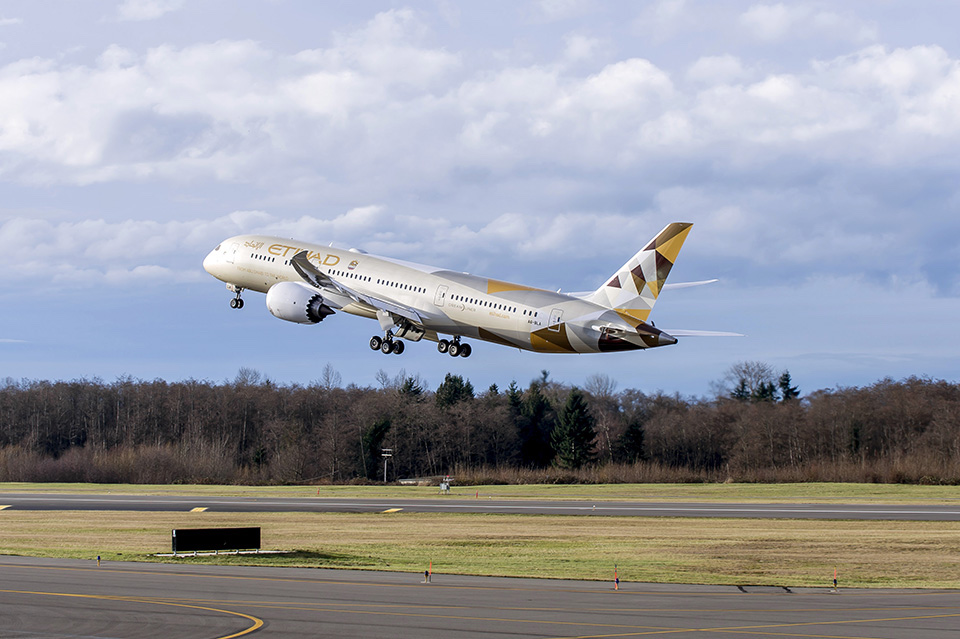
Etihad Airways is using a new EFB application called eWAS from SITAONAIR on 100 aircraft within its in-service fleet. Boeing 787-9. Photo: Boeing.
Etihad Airways is deploying a new cloud-hosted electronic flight bag (EFB) weather forecasting application across 100 of its in-service aircraft fleet that will give the UAE national carrier’s pilots access to turbulence alerting, areas of icing and other information graphically depicted on tablet screens.
The application, EFB Weather Awareness Solution (eWAS), developed by SITAONAIR in partnership with GTD, was trialed by Etihad pilots throughout 2018 ahead of its initial launch in April. A key enabler for pilot use of eWAS is AppsConnect, which is best described as SITAONAIR’s application connectivity cloud-hosted hub, where pilot EFB applications are connected to the proper available connectivity link.
As an example, in the air it can route the eWAS need for updated airport conditions at a destination airport with ACARS, or the satellite communications network that an aircraft is equipped with. On the ground, the app is automatically routed to available 3G or 4G networks to update weather forecasting data.

A weather forecasting image generated by eWAS. Photo: SITAONAIR
“eWAS fully integrates with the airline’s aircraft environment, utilizing any connectivity, operating over Wi-Fi or 3G or 4G mobile data link on the ground, or an IP link like satcom or a narrow band ACARS link. An aircraft interface device is required if connecting to cockpit communications systems,” said Toby Tucker, portfolio director for SITAONAIR told Avionics International.
There are currently 50 airlines trialling the use of the eWAS app, which has also been adopted by Singapore Airlines and Air France, Tucker confirmed.
The weather awareness application is also compatible with Inmarsat’s SwiftBroadband-Safety (SB-S) communications, which can give pilots a real-time view of changing weather conditions. Inmarsat describes the SB-S network as a digital high-speed, secure IP broadband network capable of supporting up to 432 kbps per channel. SB-S provides a prioritized IP channel — a connection that adds additional availability for IP data throughput for cockpit data and voice communications traffic. The L-band powered connection also supports uploads and downloads of the meteorological and environmental information used by the eWAS application.
Weather information is obtained by the application through a multi-source forecast format fused by weather forecasting feeds pulled from weather data providers including DTN, NOAA, WSI, Jeppesen and Meteo-France. Other features include the ability to show pilots areas of turbulence that have been reported by Etihad’s aircraft flying along similar routes. DTN, a Minnesota-based provider of visual data analytics and other graphical applications, is also supplying turbulence alerting depictions to Qantas Airways.
“This updated view of the significant weather allows the airlines pilots to have earlier visibility of the real weather scenario in a “strategic” view in eWAS, which then compliments any tactical avoidance decisions made by using the onboard radar as you get closer to any events,” said Tucker.
Etihad is deploying the new application across 100 of its in-service fleet of more than 120 aircraft. The Middle Eastern airline has launched new routes to Rome and Shanghai on the Boeing 787-10 since the beginning of June.
“The advanced communications connectivity on modern aircraft significantly improves the quality of data available to pilots, and the real-time information provided by SITAONAIR enhances their ability to anticipate, safely navigate or avoid major weather fronts,” said Guy Farnfield, Etihad’s head of flight operations support.